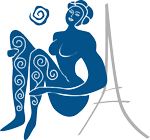From the vein to the varicose vein
What are varicose veins ?
Introduction
Varicose veins are extremely common in our population, since it is estimated that they affect 30 to 50% of women and 20 to 30% of men. This disease will be more and more frequent due to the aging of the population and the increasing problems of lifestyle. Varicose veins pose several problems :
For nearly a hundred years, the methods of treating varicose veins have evolved little. The aggressiveness of surgical treatment, the repetitive and often incomplete nature of sclerosis treatments and the frequency of recurrences very often discouraged patients. Modern management of varicose veins requires innovative techniques that have been scientifically proven in clinical practice. They always meet a triple objective: less aggressiveness, more precision, more prevention.
Anatomy and functioning of the veins
The veins of the legs are blood vessels whose essential role is to bring back the blood that has left its oxygen in the tissues, towards the heart, so that it can be oxygenated again by the lungs. To allow the blood to flow back upwards even when standing, the veins are equipped with anti-reflux valves, called “valves”, which allow the blood to flow only towards. During leg movements, especially when walking, the muscular contractions of the calf crush the veins, pushing the blood upwards, thanks to the valves.
Valves closed :
no downward flow

Muscle contraction :
opening of the valves, upward flow

What are varicose veins ?

Varicose veins are dilated, elongated and tortuous veins. Often unsightly, sometimes painful, they have different names, depending on their appearance and size. They are differentiated by their diameter. – Telangiectasias, or varicosities called “spider veins” are less than 1 mm in diameter – reticular varicose veins are less than 3 mm in diameter – varicose veins are more than 3 mm in diameter. Originally, the deformation of the vein into a varicose vein is linked to a weakness in the vein wall, probably of hereditary origin. This deformation worsens progressively, with a variable speed according to certain risk factors: importance of congenital fragility, professional or daily life trampling, weight gain, pregnancy, heat, risky sports, etc…
The deformation of the vein causes the valves to spread apart, allowing blood to leak downwards. This is called venous reflux. A vicious circle is set up: the reflux creates a local hyperpressure which worsens the dilatation, which in turn worsens the reflux and so on…
The dilation then becomes permanent: a varicose vein then appears on your legs. This phenomenon will extend from one step to the next to the neighboring veins and contaminate a superficial venous network that is more and more extensive. This is the enlargement and extension of varicose veins whose speed of evolution can vary greatly from one patient to another.
Subsequent complications of varicose veins
Varicose veins can lead to two types of complications :
Today, there are modern treatments that are not very aggressive and incapacitating (see treatments section) and that make it possible to avoid the occurrence of complications. Good information of patients leading to an early and adapted treatment should thus allow to avoid these complications of venous insufficiency.




